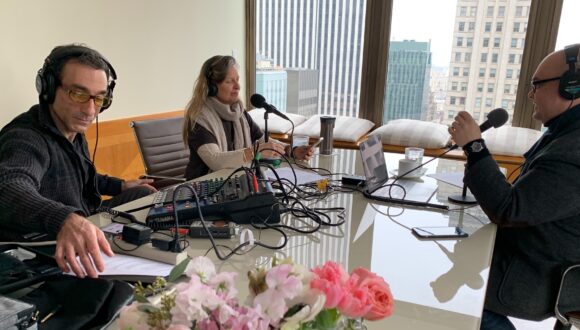Episode 38: Driving Efficiency With an Optimized Tech Stack
Research from LinkedIn found that 54% of sellers say sales tools enable them to build trust and close deals with buyers. So, what role does an efficient tech stack play in creating an effective enablement strategy?
Shawnna Sumaoang: Hi and welcome to the Win Win Podcast. I’m your host, Shawnna Sumaoang. Join us as we dive into changing trends in the workplace and how to navigate them successfully. Here to discuss this topic is Rey Espinosa, senior product consultant at ODP Business Solutions. Thanks for joining, Rey! I’d love for you to tell us about yourself, your background, and your role.
Rey Espinosa: Absolutely. I definitely want to extend my thanks and gratitude for having me join the podcast. As for myself, I’ve actually got about close to 30 years of experience in sales and sales-related roles. I spent about 10 years actually as a frontline sales rep or account manager, and I managed some sales teams. The bulk of my tenure has actually been in a corporate training role, wearing any and all the different hats that trainers wear, facilitator, certified sales instructor, content and rhythm creator, coach, and just everything that’s involved with that. That’s the bulk of my experience. About just over a year ago, our organization adopted Highspot and actually invited me to be the Highspot solution owner for ODP Business Solutions. That is my current goal and I’m loving every moment of it.
SS: Well, thank you again so much for joining us today, Ray. I really appreciate it. Now, I want to get started with obviously understanding what the landscape looked like before. Before Highspot, what were some challenges your organization was experiencing? How have you been able to solve these challenges since having Highspot in your tech stack?
RE: Well, where to begin on this one? The challenges that we’re really facing in our organization with our old content management system really were number one. There was just an overwhelming amount of content on the platform. Our sales teams were challenged with trying to find the content. Even to add to that, when they would find content, a lot of it was out of date, it was old, it was irrelevant, and not usable to share with our customers.
Implementing Highspot, afforded us the opportunity to really wipe the slate clean, which is a great benefit for the organization. We really took a hard look at the content that we had, and we made that conscious decision to be very intentional about what we brought into Highspot. We made sure we only brought in the most recent and relevant content. A few assets were updated to make sure that they were up-to-date and relevant, and then we excluded a lot of content. That allowed us to start from a really great point with our content. We knew the content that was getting uploaded was up to date, it was relevant, it was really healthy.
Also, with this smaller amount of content, it addressed the challenge that our sales teams had with trying to find content easily and quickly, and they knew whatever they would find in Highspot was going to be up-to-date and it was going to be relevant for today’s business landscape. Going through this process, just helped to improve efficiencies and the overall perspective that our users had on the content that we had available for them to use with their customers.
SS: I love to hear that. Now you have also been doing amazing within your organization at ODP Business Solutions. You have an 81% recurring usage rate of the Highspot platform, which, as I said, is outstanding. I’d love to learn from you. What are some key ways you integrate Highspot into seller’s workflows and how has that helped to drive adoption?
RE: Well, there’s a couple of different ways that we’ve done this. From its inception, Highspot has had some really great integration tools and capabilities into the other software tools in our tech stack. That really helped to promote and drive the adoption of the platform. We’re able to provide them access to the content from Highspot through Outlook, through our CRM, and through some of our other sales tools that we’re using. That really helped with adoption. It was easy to get to and easy to use from whichever tool they happened to be using in their workflow.
The other thing that really helped out is we made sure that we had constant and consistent messaging about Highspot to all of our teams. We made sure that they understood that Highspot is out of one source of truth, the content, whether it’s marketing content, product information, process documents, training, or what we wanted our sales teams to know, and they’ve learned that if you’re looking for anything, start with Highspot.
SS: I love that principle. What are some of the benefits of integrating Highspot with some of the other core tools in your tech stack, like Salesforce CRM, for example? What are some of the key business results that you’ve seen as a result of that integration?
RE: Well, again, it goes back to really the strong partnerships that Highspot has with a lot of the other vendors and companies out there. The biggest and most seamless integration that we have with Highspot is within our CRM. The integration that Highspot has with Salesforce allows us the ability to serve up content to the reps while they’re in Salesforce during their normal flow of business and processes.
We have the ability to serve up content at the account records, that opportunity, and contact records, and we can pick and choose what content we want to show for different accounts or different stages in an opportunity or different products that are associated with an opportunity. That was one of the core integration pieces that we love about Highspot. Just to add icing to the cake, you have that integration with Outlook. As a sales rep is starting to create an email interaction or engagement with the customer, they can easily drop in relevant content. The same goes for another tool that we use called Sales Law. There is another great simple integration to bring in content from Highspot when they’re using that tool.
That integration really just permeated through all of the tools that we really use and that our sales teams use on a day-to-day basis. The biggest benefit was that our sales teams didn’t have to adjust or change their processes drastically. It was just a small tweak here and a small tweak there to make sure they’re aware, this is how easily and quickly you can get to the content you need to share with your customers.
The biggest key business results that we’ve seen are improved efficiencies. Reps are able to go in, find content that they need, or we serve up the content that’s most relevant at that moment in time when they really need it for their customers. They’re spending less time doing what we call admin tasks. They’re not having to search for content or figure out what content to use, or even utilize the template capabilities, or pitch templates within Highspot. Now we’re presenting those messages where they’re simply just personalizing it a little bit and sending it out to the customers. It’s a huge improvement in efficiencies, which frees up time to let our sellers do what they’re paid to do, which is engage with our customers, bring the value of a partnership between our organizations, and drive profitability and revenue.
SS: That’s absolutely what the goal should be in terms of where reps are spending and focusing their time because it ultimately drives productivity. Now, I know that, especially in Salesforce, you have been working on a big project to basically build in targeting in Salesforce to ensure that you can deliver that just-in-time content for your reps. Can you tell us a little bit more about this project and how you’re leveraging the Salesforce integration to continue to further improve rep workflows and efficiencies?
RE: Absolutely. With the adoption of Highspot, the first steps are really getting the platform stood up and making sure that the framework is there, you have the right spots, lists, filters, and just everything is all set up so that you can manage that content. The next big step that we’re looking at is now serving up that content, and improving those efficiencies with our users, which are our sales teams.
I guess the easiest way to put this is as you start to want to drive business, businesses have campaigns and initiatives, different pages or different plays that they want to push out where we feel we can generate revenue and bring more value to our customers and with Salesforce and the integration that Highspot has with Salesforce, it allows us to present those initiatives or those campaigns. All of the information that’s relevant to those campaigns and initiatives can be right there at the targeted account. By bringing it up and integrating it into the account record, we now present that data or serve up that information right there on the account and make the sales teams aware, hey, this particular account is really primed and targeted for this initiative. Start to talk to them about these products or these services and solutions.
The great thing is we use play pages from Highspot and we leverage that to know, say, show, and do structure so that they can quickly go to that page, read through it and really understand what they need to do. This really ups their competency level about talking to their customers and how they want to talk to their customers, what they would like to show, and how they can really position the value that we can bring. That’s one of the first real heavy integrations that we’re doing at that account level within Salesforce. Right on its heels is going to be that same type of serving up of content and information on the opportunities. We can serve that up depending on the stage of the opportunity, depending on the product that’s related to that opportunity.
The next step beyond that is looking at the contact level. The individual person that we’re dealing with. We can see what they are engaging with because we want to leverage and serve up the right content at the right time, given that the customer’s title or the industry they’re in, is the decision maker, there are various pieces of information that are available within Salesforce that will allow us to serve that content up that’s going to resonate with that customer, given their buyer persona or their buyer type. You have to speak to a C-suite individual a lot differently from an end user or mid-level manager that has different priorities. Different things resonate with different customers and having the ability to serve up content, we know, is going to resonate with that particular type of buyer is really going to help to generate the interest from that customer and want to actually have those conversations with our sales teams.
SS: That is an amazing undertaking of work though, Ray, so congratulations on that project. I think it’s going to be extremely beneficial to your sales teams. Now, another topic that I know is near and dear to you, and also a way to help your teams improve efficiency, is through this notion of governance. You actually shared your insights on your governance strategy at our annual user conference, Spark ‘22, last fall. From your experience, and for the podcast audience that may not have been able to join that session, what is the importance of content governance, especially when productivity is so crucial to a company’s success?
RE: In a nutshell, the importance is really having up-to-date, relevant, and what we like to kind of call healthy content. You want to make sure that whatever information you’re providing to your customer, it’s going to be relevant for today’s business landscape. As we all know, over these last couple of years with everything that’s been going on in the world, business has changed dramatically. Making sure that the content that you have, the information that you’re sharing with your customer is up to date and reflects how that landscape has changed is going to resonate more with them than just a flier or a brochure that you printed back in 2018 or 2019. The same key points and value that you were trying to present at that moment in time aren’t really relevant anymore given the landscape and the shift in how we’re doing business today.
It all starts with that content governance and making sure that the assets and the content that you’re loading into Highspot it’s up to date, relevant, and healthy. For me, it even goes beyond that. There’s more to consider than just making sure that you’ve got a relevant title and a description, expiry date, and that it’s tagged appropriately for list builders in Highspot. We need to look at the overall spots. The list that you’ve created, the pages that you’re creating from a landing page to a spot overview, to a list overview page, the different play pages, all of that I think is within that realm of governance. I mean, it’s great if you write a really great book, an awesome novel, but if you go into a library and you can’t find that book, nobody’s ever going to know it’s there.
The way that you structure the framework of Highspot is part of that governance as well. If you can do that right and keep it updated, you’ll have to refresh it. It’s not something where it’s one-and-done. You have to revisit it and make sure that you’re keeping up with how you’re doing business and your customer base and your product lines and things like that, but if you keep it up to date, it’s much easier for reps to find what they need. It involves a lot more than just the uploading of content and tagging that and putting an appropriate title on it, it also involves some of the layout and structure of the environment. You want to make sure that when you’re creating your framework and the strategy for presenting content to your sellers that it makes sense, that it is intuitive, and that it’s easy for the end users to find that information. That’s really what’s going to drive the efficiencies, drive productivity, drive revenue. It all starts with governance, but it goes beyond just making sure that you’re checking a couple of boxes on the content properties. It goes well beyond that to really drive that home.
SS: Amazing. You guys, as I said, have been doing phenomenal with governance within your instance. Your governance health score consistently remains at 75% or above, which, as I said, is absolutely incredible Ray. Fantastic job. I’d love to learn a little bit more about our other customers that are really keen to implement governance best practices. How do you partner with spot owners and publishers inside of Highspot to ensure that Highspot is filled with relevant content for your sellers?
RE: It’s a combination of meetings, collaboration, and partnership. With our spot owners and our publishers, we meet with them monthly. As I mentioned before, we’ve only had Highspot for about a year, but these monthly meetings really help to make sure that our spot owners and our publishers, number one, are keenly aware of how important their role is in the Highspot platform and our governance and just overall content management strategy. They need to know how important they are. Having that constant consistent communication and two-way communication really is helping us out.
It makes sure that the spot owners and the publishers feel as though they kind of own a part of Highspot. It’s not just another process that they have to incorporate. It is their baby, as much as it is mine. That constant meeting with them on a month-to-month basis helps out. Beyond that, we also have implemented a Highspot end user committee and a Highspot sales leader committee so that we can meet on a monthly basis with our users. We get their feedback, we make sure that they’re aware of new features, new capabilities, new strategies that we’re implementing features in and capabilities that are integrated into Salesforce. This way they know what they’re going to see and how easy and quick it’s going to be to get to relevant content, but then allowing them to give that feedback as well.
Now, as part of the sales enablement team and owner of Highspot, we can take the feedback from the users, spot owners, and publishers to vet that out to figure out what we can really do. Once we understand that, now we help to partner with our marketing, our product, our merchandising, our sales op teams, and support teams, and our training teams to say, okay, this is what we really need to do. This is the direction that we need to drive Highspot because it’s going to really help from a content management upload process for our publishers and our spot owners, but it’s also going to have a very positive impact on our users. You have to keep an eye on both of those groups. One helps you to maintain the health and structure of the platform, but the other one is the users.
You can build this great efficient car, but if it’s ugly and it’s cramped and you’re not comfortable sitting in it, many people aren’t going to buy it and use it. On the other side of that coin, if it’s really a great-looking car and it’s comfortable and all that great stuff, perfect, you’re going to get a lot of people buying it, but if you didn’t build it the right way, it’s going to break down quickly, so you have to balance those two. I think we’ve done a great job at our company to make sure that we’re facilitating this two-way communication and feedback loop to make sure everybody’s voice is heard and that they understand that your idea, as wild as you may think it is, is maybe the perfect solution for what we need to continue to drive Highspot to drive efficiencies and productivities and drive revenue.
I know that they feel that way because they’re more than welcome to throw out ideas during our meetings and just say, hey, it would be great if we could do this if we could have that. A lot of times we talk to our Highspot support team, which is great, they’re awesome, and they say, yeah, we can do that. Highspot again, just shows its colors and it shines bright at everything that it can do to help support our business.
SS: I love that, Ray. Now another area, because you brought up the topic of partnership that has been crucial to your enablement strategy is training. Can you tell us about how you partner with your training team to optimize training programs using Highspot?
RE: Absolutely. Yeah. I do have maybe an ace up my sleeve on this one, just because I actually was part of the training team and, again, my years of experience in training, but the capabilities that Highspot has really came at the opportune time. We actually don’t have a formal learning management system here at ODP Business Solutions. We were making do with what we could and creating some ad hoc programs to meet our training needs. With the implementation of Highspot, it gave us pretty much everything that we needed within the platform to support our training teams.
When I first came in and started to manage the implementation and really started to drive the solution for our organization, learning more and more about the capabilities of training, I couldn’t wait to get back in touch with the training team to say, hey guys, we now have a tool that can do right out of the box 85 to 90% of what we were trying to do as a sales team. Let’s meet and let’s start showing you the features and capabilities and let’s start building out our training programs. We now have an onboarding training program, as well, as a really good strategy for our continuous education programs within Highspot.
We’re also taking advantage of some of the new features. We’re really, again, leveraging, and I’m going to tout our Highspot success team. They’re always willing to meet with us and make sure that we’re aware of features and functionality that they feel are going to benefit us. We meet with them every two weeks, rain or shine. They really take the time to understand, from a training perspective, what our training team is trying to do. They can really highlight the features, capabilities, and functionalities that align with those goals and those projects that we have for training. With all of that tied together, it’s just another aspect of Highspot that I can’t speak highly enough about.
We now have an individual on the training team who’s getting more and more familiar with Highspot training capabilities and functionality, so they’re working very hard to get everything into Highspot for onboarding because we do have onboarding for our field sales teams and we have a different onboarding program for our inside sales teams. He’s working to bring all that together. I partner with him. Not only do we meet with our Highspot success team every two weeks, but David and I meet at least four or five times a month because he wants to learn how I can use Highspot for courses, lessons, and certification programs. We really love the most recent feature that’s been released, which is the event sessions. That’s a game-changer for us. We love the ability now to create virtual meetings or in-person meetings right within the structure of course. That is just another great feature that Highspot has released.
SS: Beyond sales training, you’ve also engaged in some personal learning programs through Highspot University courses. How have professional development opportunities like these courses help you to continuously optimize your enablement strategy and your use of high spot?
RE: Well, for me, being the content management and the solution owner for Highspot, this is something new for me. I’ve never had these types of roles and responsibilities. I’ve always done training. That’s my bread and butter, so to speak. I had a lot to learn about sales enablement, about content management. The Highspot University is a great initial tool to really kind of get you in tune with Highspot and how to use Highspot for managing people for governing content or adding content. They’ve got some great courses out there and I know you guys are going to continue to build out the offerings that are in Highspot University.
Beyond that, I would also like to give a huge shout-out to the Highspot community. I mean, I go to the community page at least three times a week. I tried to target about an hour in the morning. I’ll focus on governance, one-day sales play the next day, different topics, and different categories each day to continue learning more about what is it, what does sales enablement do, and how can we make it better? What are some of the things that we should be aware of, should be looking at, and should be helping to drive in our organizations? That along with looking at the discussion forums in there and really understanding a lot of the questions that I have about Highspot and how to use it, a lot of other folks out there have those same questions.
Those discussion forums really helped to bring together a huge number of like-minded people that want to improve not only themselves, but Highspot and the environment for their organizations, but really help the leverage and knowledge that we each have little tidbits here and there. Everybody is very supportive of that platform. The community is another great way that helps me to continue to learn. I’ve seen myself as an instructor or a teacher for many years, but it really got me excited to be back on the other side of the fence to be a learner and to learn new things. I know it’s kind of an old saying that you can’t teach an old dog new tricks, but I can tell you, I’m an old dog and I’m learning some new tricks thanks to the Highspot community.
SS: I have to say, Ray, that quote alone may have made my whole day. Thank you so much for sharing that. To close, I have one last question for you. What advice do you have for other teams to optimize their enablement strategy with Highspot?
RE: I thought a lot about this question and, you know, I kind of doubted myself in trying to respond to this question to be perfectly honest, Shawnna. I don’t have a lot of experience. I don’t have a lot of experience or time behind this particular driver’s seat, but from what I have been learning, I think the best advice I can give is just to be very open and have very strong, open lines of communication. Not only between the individuals that are helping to manage Highspot or that are on your sales enablement team but really the two-way communication between your marketing teams, your product teams, your sales teams, training, and sales operations. Everybody needs to be involved in and has some level of involvement and kind of skin in the game when it comes to sales enablement.
As a sales enablement team, we’re not on this island just trying to throw up smoke signals and tell people what to do. You really have to take the time to meet with individuals, understand what they’re doing, their projects, their roadmap, and then how that roadmap and how do those projects tie into initiatives, campaigns, training programs, and even just the overall presenting or managing of the content and presenting that content to sales.
Ultimately, as sales enablement, we really want to drive profitability and the success of our sales teams and our organization, but in order to do that, you have to have a full understanding of your business, your business landscape, and the direction that the business is going in. Then be able to look a little bit farther than that on the overall landscape outside of your organization, what’s really working. How can we improve things?
The best advice I could give is communication, two-way open, honest, free communication. There’s an old saying in training that says there are never any dumb questions, only dumb answers. Don’t be afraid to ask those questions to learn and make sure that everybody feels comfortable sharing their ideas because you never know when that one idea is going to come out that’s really going to put you leaps and bounds ahead of the game.
SS: Ray, I have to say you nailed that advice. Thank you for sharing that with our audience. And thank you for joining us today.
RE: Well, thank you. It’s been my pleasure. I enjoyed speaking with you. I even get a little bit tongue-tied every time I start to think about Highspot and what it can do, and I’m so excited about what it’s going to bring for our organization and everyone else in the future.
SS: Fantastic. Thank you, Ray. To our audience, thanks for listening to this episode of the Win Win podcast. Be sure to tune in next time for more insights on how you can go beyond what good looks like with Highspot.





